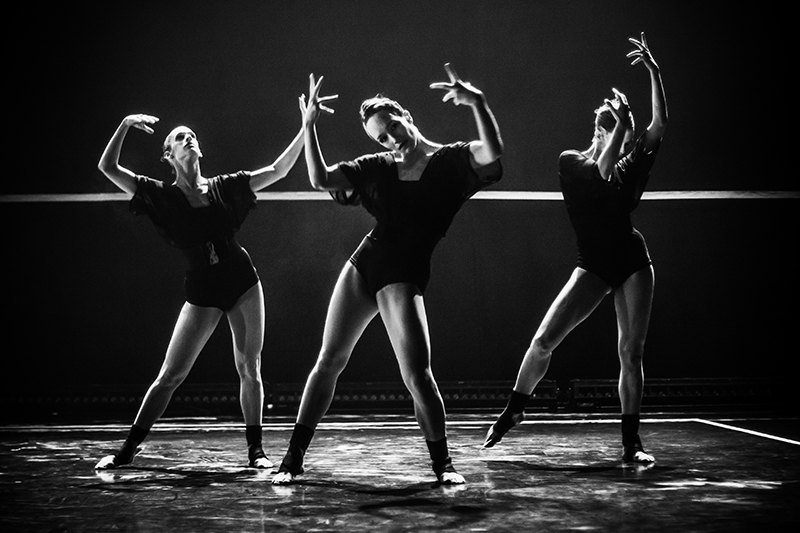Kingsbury Hall Presents Gallim’s BLUSH and a New Model for Touring to Utah
Art
Tuesday night, February 11, I went to see Gallim Dance, a New York–based company with Utah and Israeli connections. Their show was at the Marriot Center for Dance, just west of the University Library, but the performance was presented by Kingsbury Hall. Says that institution’s John Caywood in the program notes: “This is the first time [we have] presented at a campus venue other than the Marriott Auditorium in Kingsbury Hall.” Bringing Gallim is a departure from the less-than-edgy big name acts we’re used to seeing at Kingsbury e.g. Pilobolus, the Blue Man Group or Paul Taylor.
Whatever judgement one makes of Gallim’s 2009 work “BLUSH,” this is clearly an historic moment in the development of new models for presenting live performance in the state of Utah–– if Kingsbury keeps partnering with the College of Fine Arts departments in this way, their offerings might get a whole lot more interesting. It’s worth mentioning that Kingsbury Hall isn’t the only institution in Salt Lake that’s working on the problem of how to frame experimental work and bring it in from out of town. In May, Sugar Space will bring the European improvisor Katie Duck to town for a series of workshops and performances. loveDANCEmore is working on independently presenting Natosha Washington, a local choreographer formerly of Raw Moves. They’ve also presented New York–based choreographers Miguel Gutierrez, Diana Crum and Regina Rocke since 2010.
“BLUSH” is in many ways a logical choice with which to begin such a conversation. Andrea Miller lived here for a time as a kid, where she attended Virginia Tanner Dance, before going to Isreal to study Ohad Naharin’s Gaga technique. At first glance, “BLUSH” seems very experimental. It freely borrows from Butoh vocabulary, creating little vistas of extreme slowness and taught emotion while the five other dancers whirl past in patterns tightly controlled counterpoint. Ballet lines are torn apart, vigorously––as in one memorable moment where Emily Terndrup’s head is roughly grasped as if by a junior high school bully––somehow she still manages a series of striking split jetes while being run around the playground.
In other ways, Gallim is quite conservative. Like many much older companies, such as our own Ririe-Woodbury, the cast of “BLUSH” is an even three men and three women, who are often grouped as such in Miller’s blocking. The men are shirtless and the women are in black leotards. They’re all fit and good looking without being strikingly different from each other. Both sexes wear ankle braces which warn of the disregard they’ll be compelled to give to their joints in the heat of the action.
Out of the seven sections of “BLUSH,” one stands out as representative of the whole. It could almost have been it’s own succinct little dance. In a melodramatic move, this duet between two of the men is set to Arvo Pärt’s “Fratres.” The stage clears, and Dan Walczak and Daniel Staff are left to explore each other. Despite the heavy handed score, the duet accomplished in miniature everything that happened on a more precarious scale in the rest of the work.
They threw each other around, grabbing and flinging each other by ankles and wrists, moving fingers out of the way just in time and marking their territory on the way. One would thrust out of the floor lead by the pelvis, only to crouch back dramatically as his own pair of turned-in knees buckled below. As they wrestled and ran from each other, the white paint finally started to make sense––here was the blush, and it was rubbing off. (Up until then, I had just assumed the paint was a reference to the work’s Butoh influences.)
The mixture of violence and skillful camaraderie at play here translated less well on to all six men and women. In one passage, the three men handle one of the women like a sheet being spread out of a mattress, flinging her up and down carelessly until they’re satisfied with how she spreads out on the ground. Since there’s no clear narrative or character development, this violence exits in a void, and rather than saying anything, just feels gratuitous and distracting from the dancing.
I’ve learned over the years to have patience with this kind of behavior on the part of artists––sometimes the repetition of difficult imagery is a necessary tool. But after the first half hour of “BLUSH,” I’ve seen so much energy expended––but it doesn’t seem to have moved us very far. In the penultimate section, the six run in circles like a pack of tired wolves, half-singing along to a catchy pop song, “I’ll Believe in Anything” by Wolf Parade.
Miller is adept at marketing, and I wonder if that ever hamstrings her as an artist. This choice in particular feels calculated. Is she just trying to fit the dancing that pours out of her own body into a package that will appeal to a broad demographic of smart, interesting, moneyed people––some of whom might listen to Wolf Parade and some who might prefer Pärt? Each time they mouth the refrain “nobody knows you and nobody gives a damn,” one of the six breaks out of the running to stop and stare dumbfounded into the audience, maybe ecstatic, maybe just stunned. I think it’s meant to be a transcendent image, of an individual experiencing the fragility of her solo identity. They look at me for a moment before falling back into the fray. I wish I knew what they––or their choreographer––were thinking.






